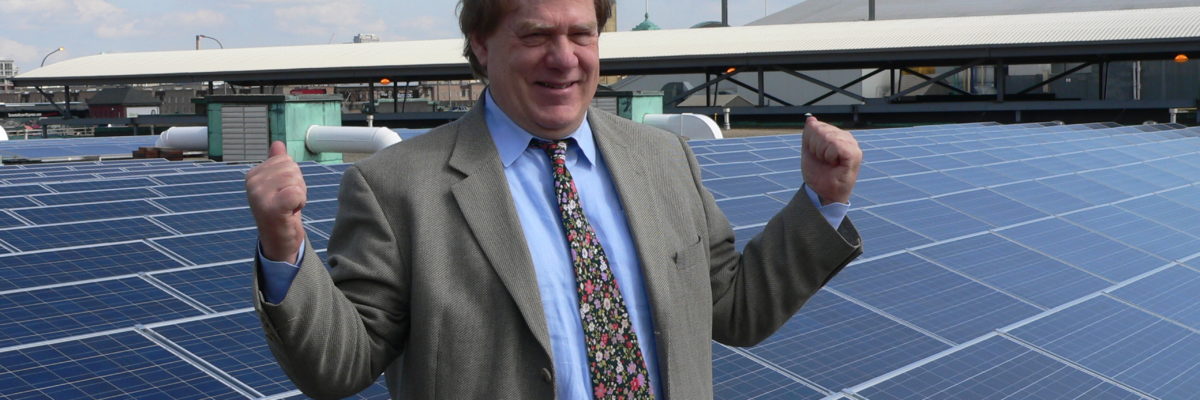In celebration of TAF’s anniversary, guest blogger Philip Jessup reflects on 25 years of Toronto climate action. Philip co-chaired Toronto’s environmental committee that first recommended the Toronto Atmospheric Fund (TAF) to Council, served on its inaugural board, and was its staff director for nine years.
Over the past 30 years, I’ve led various Canadian and international efforts to reduce greenhouse gas emissions (GHGs) in cities. As the federal and provincial governments struggle to hammer out a pan-Canadian carbon price, I wonder whether they’ve overlooked a potential partner that could slash emissions nationwide: Canada’s cities.
Take Toronto. Despite robust economic and population growth, city-wide emissions have dropped 24 percent since 1990. The City’s own emissions — from over a thousand buildings, a fleet of vehicles, and waste management — are down 46 percent. By contrast, Canada’s emissions grew 20 percent, driven by fossil fuel extraction.
Behind much of Toronto’s remarkable achievement was adoption of innovative technologies, GHG reduction programs and policies incubated by a small special-purpose agency: Toronto Atmospheric Fund (TAF).
Now celebrating its 25th anniversary, TAF was the brainchild of a City Council led by Mayor Art Eggleton which created the agency in 1991 and endowed it with $23 million from the sale of surplus City property. TAF has invested the capital ever since, using the returns to seed innovative projects, advance game-changing policies, and demonstrate and de-risk low-carbon solutions to help the City achieve its ambitious climate targets. The endowment has been invested three times over supporting over $50 million in community grants and investments and shaving $60 million off the City’s operating budget. All this at no cost to the taxpayer.
What can Canada’s senior governments learn from TAF’s success?
First, a strategic focus is essential. TAF produced Toronto’s first GHG inventory which revealed waste as a key source of emissions. As a result, Toronto became one of the first cities in the world to capture methane leaking from landfills and turn it into green power, simultaneously shrinking a major GHG source and creating a new revenue stream.
Second, seeing is believing. The adoption of new green technologies or programmatic approaches carries inherent risks that are more appropriately advanced by an independent innovation group like TAF. If a new initiative fails, municipal staff who champion the innovation may fear being sidelined. Pilot projects designed at TAF to test and verify results de-risked new technologies. Thus, a wide variety of advanced technologies have been adopted across the city, from industrial wind and solar electricity generation at Exhibition Place, to LED traffic signals, to electric vehicle adoption in Toronto’s fleets.
Third, working with others. To bring new innovative solutions to scale, TAF figured out over the years how to bridge different sectors, building understanding of the needs of stakeholders with capacity to lead significant carbon reduction. These include public agencies, energy utilities, the Federation of Canadian Municipalities, and major developers like Tridel.
Fourth, government policy is key to scaling innovation. TAF provided early and sustained support to the Ontario Clean Air Alliance, a coalition of 90 municipalities, companies, and citizen organizations instrumental in the phase out of Ontario’s coal-fired power. This became the single largest GHG reduction in North America.
Finally, change takes time. Financial sustainability ensures an agency like TAF can stay on its game for the long haul. In addition to a permanent endowment, TAF has a robust governance structure including a Council-appointed board and expert community membership on two advisory committees.
Several examples of TAF’s work tell the story.
- Deep lake water cooling—TAF created a joint venture with Toronto District Heating Corporation in 1996 (later Enwave) to implement a crazy idea: pump cold water from the depths of Lake Ontario to cool downtown buildings in summer. TAF’s $150,000 established credible engineering and financial parameters, and then partners stepped up with large grants and loans to advance the project. The plant cut electricity bills in 100 buildings while reducing strain on the downtown electricity grid.
- TowerWise—Because half of Toronto’s emissions come from buildings, energy efficiency is TAF’s top priority. By pioneering an integrated engineering and financing model to retrofit Toronto Community Housing buildings, as well as condos, co-operatives and commercial buildings, TAF is building confidence in the retrofit business case and mobilizing private financing. Social housing projects also showcase how to improve indoor air quality for some of the City’s most vulnerable people.
- Smart Commute—This employer-based program helps commuters try smart travel options, including carpooling and cycling. Since 2004, the program has eliminated nearly 1.3 million single driver trips, removing 10,000 cars daily from the roads, relieving congestion, and reducing air pollution. Smart Commute started as a modest pilot by the North York Chamber of Commerce, pioneering the concept of transportation demand management in Canada. TAF funded the start-up and development support for the initiative’s first decade, after which Metrolinx adopted and expanded the project.
To meet national climate commitments, Canada needs to embrace innovation, rapidly scale up new technologies and approaches, and mobilize public and private investment in low-carbon solutions. While a national price on carbon will create a framework that incentivizes provinces and business to do the right thing, it won’t be enough.
Thinking globally and acting locally is the cornerstone of innovation. To help Canada meet its obligations as a signatory to the Paris Climate Agreement, senior governments should ensure that Canadian cities are resourced with their own brands of independent, innovative climate agencies to create and advance local climate solutions.

